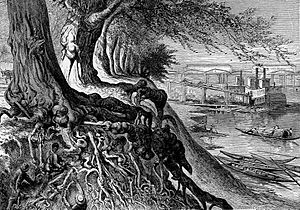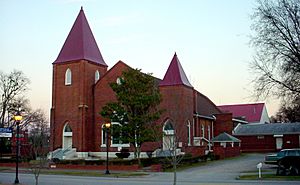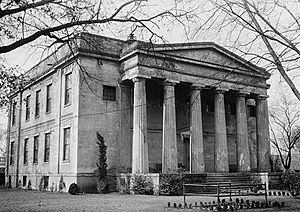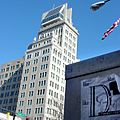History of Augusta, Georgia facts for kids
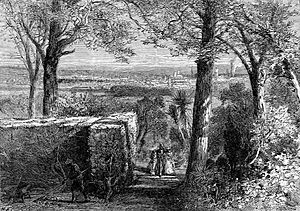
Augusta, Georgia, was started in 1736. It was part of the British colony of Georgia. James Oglethorpe, who founded the colony, oversaw its beginning. Augusta was the second town built in Georgia, after Savannah. Today, Augusta is the third-largest city in Georgia. It is also the biggest city in the Central Savannah River Area.
Contents
Early Days of Augusta
Long ago, Native Americans used the area where Augusta is now to cross the Savannah River. This was because of its special location on the fall line, where rivers become shallow.
In 1736, just two years after James Oglethorpe started Savannah, he sent soldiers up the Savannah River. He told them to build a settlement where the river was easiest to travel by boat. Noble Jones led this effort. The new town was meant to protect the colony from the Spanish and French. Oglethorpe named the town Augusta to honor Princess Augusta of Saxe-Gotha, who was the wife of Frederick, Prince of Wales.
The town was built on flat land near the Savannah River. Most of the time, the people of Augusta lived peacefully with nearby Native American tribes. These included the Chickasaw, Creek, Yuchi, and Shawnee Indians. The Shawnees in this area were sometimes called Savano Indians. The name of the Savannah River comes from their tribal name.
In 1739, work began on a road to connect Augusta to Savannah. This road made it easier for people to travel to Augusta by horse, not just by boat. More people then moved to Augusta. Later, in 1750, Augusta's first church, Saint Paul's, was built close to Fort Augusta.
Augusta's relationship with the Cherokee tribe, who also traded there, was not as good as with other tribes. During the Anglo-Cherokee War, Cherokee war parties came near Augusta. The Creek tribe helped push them back.
Even though James Oglethorpe first banned slavery in the colony, it soon became a big part of Georgia's history. In 1777, Georgia got a new constitution and a new way of governing. Augusta's local government changed from a parish to a county government. This new county was named Richmond County, after the Duke of Richmond.
From Revolution to Civil War
During the American Revolution, the British took control of Savannah. This made Augusta the new state capital, and a target for the British. On January 31, 1779, British Lt. Col. Archibald Campbell captured Augusta. But he soon left because American troops were gathering nearby. Augusta became the state capital again, but not for long. The British took Augusta once more before the war ended.
After the Revolution and leading up to the American Civil War, Augusta grew a lot. With the creation of the Augusta Canal, Augusta became a leader in making textiles (cloth), gunpowder, and paper. The Georgia Railroad was built in 1845. This connected Augusta to Atlanta by train. The railroad also linked to the Tennessee River at Chattanooga, Tennessee. This gave Augusta access to the Mississippi River. It became much cheaper to move goods from the middle of the country to the Atlantic Ocean using the Savannah River. This greatly increased trade.
In 1845, a major religious group, the Southern Baptist Convention, was founded in Augusta. Today, it is one of the largest Protestant groups in the country. There were growing disagreements between Baptists in the North and South about slavery. So, southern Baptists decided to form their own group. They met at the First Baptist Church of Augusta in May 1845 and created the Southern Baptist Convention.
By 1860, Augusta had a population of 12,493 people. It was the second-largest city in Georgia at that time.
From Civil War to World War II

At first, many people in Augusta were excited about the Civil War. The new Confederate Powderworks was the only permanent building built by the Confederacy. More than 2,000 Augustans left to fight in the war. But the reality of war hit Augusta in the summer of 1863. Thousands of refugees from areas threatened by fighting came to Augusta. This led to shortages of housing and supplies. Then, General Sherman's army came close, causing panic. However, Augusta was never burned down.
After the war, Augusta and Georgia were under military rule during a time called Reconstruction. During this period, African Americans gained more civil rights. But after Reconstruction ended, new laws called Jim Crow laws were put in place. These laws limited the rights of African Americans. These limits were not removed until the Civil Rights Movement in the mid-1900s.
For example, the Richmond County School System refused to educate African American students. In 1899, parents took their concerns to the Supreme Court in a case called Cumming v. Richmond County Board of Education. The court's ruling at the time said that how states used their money for schools was not a federal issue. This ruling was later changed by the Brown v. Board of Education case.
In 1828, the Georgia General Assembly officially approved the Medical Academy of Georgia. The school started training doctors in two rooms borrowed from the City Hospital. By 1873, it joined with the University of Georgia and became the Medical Department of the University. This school later became the Medical College of Georgia in 1956. In 1914, University Hospital was built near the Medical College. This helped create a large medical area in the city.
Unlike many Southern cities, Augusta did well after the Civil War. By the early 1900s, Augusta was one of the biggest inland cotton markets in the world. A new military camp, Camp Hancock, opened nearby during World War I. In 1916, a big fire destroyed over 700 buildings in the city, including many beautiful homes.
In 1927, Owen Robertson Cheatham started the lumber company Georgia Pacific in Augusta. It later moved to Portland, Oregon, and then to Atlanta.
Before World War II, the U.S. Army built a new fort in Richmond County called Camp Gordon. It was finished just days after the attack on Pearl Harbor. Many new soldiers came to this camp to train for the war. After WWII, many soldiers returned home, and the army's importance in the community seemed to lessen. Music legend James Brown, who grew up in Augusta in the 1930s and 1940s, often performed for the soldiers.
From World War II to Today
Augusta's Growth and Changes
In 1948, Augusta saw new growth when the U.S. Army moved its Signal Training Center and Military Police School to Camp Gordon. Later, in November 1948, the Clarks Hill Reservoir was created by a new dam. This dam gave the city a supply of hydroelectric power. In 1950, plans were announced to build the Savannah River Site nearby. This project would increase the city's population by about 50,000 people. Augusta was becoming a major industrial center in the South.
Today, E-Z-GO and Club Car, the two largest golf car makers in the world, are based in Augusta. The Norfolk Southern and CSX train lines run through downtown Augusta. The city is also home to large private companies like Georgia Bank & Trust and CareSouth.
Challenges and Renewal
The Civil Rights Movement also affected Augusta. In 1961, soul musician Ray Charles canceled a show at the Bell Auditorium. He learned that black and white audience members would be kept separate. In May 1970, following civil rights protests, six African-American students were killed by police. This led to a riot where many buildings were set on fire.
Today, African Americans make up about 53.6 percent of the population of Augusta-Richmond County (2006 estimate). While slavery and Jim Crow laws are in the past, discussions about race relations continue in city politics.
Starting in the late 1970s, businesses began to leave downtown Augusta for malls like Regency Mall and Augusta Mall. This caused parts of downtown to decline. To fix this, city leaders worked to improve Augusta's riverfront, which was hidden by a levee. They created Riverwalk Augusta, with parks, an outdoor theater, hotels, museums, and art galleries. The first part of Riverwalk Augusta opened in the late 1980s and was expanded in the early 1990s. However, these improvements didn't immediately help Augusta's main street, Broad Street, as more businesses kept leaving. Broad Street is the second widest Broad Street in America.
Bringing Downtown Back to Life
In 1995, artists and downtown supporters started a monthly event called First Friday. This night festival aimed to bring people back downtown. It featured local bands, street performers, and art galleries that stayed open late. Since 1995, more businesses, including many new restaurants and bars, have returned downtown. A section of upper Broad Street is now called Artists' Row. It has several local art galleries. First Friday still happens today, along with other efforts to improve downtown. For example, Enterprise Mill was recently updated to include business offices and apartments.
City and County Join Forces
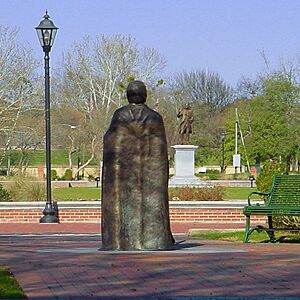
In 1995, people living in the city of Augusta and Richmond County voted to combine their governments. However, citizens of Hephzibah, Georgia and Blythe, Georgia chose to keep their own separate governments. This consolidation officially started on January 1, 1996. The city of Augusta gave up its old city charter and merged its operations with Richmond County.
Augusta Today
The Augusta Museum of History shows off Augusta's past and its famous people. Historic Augusta has also helped save important old buildings throughout the city. There are plans to develop downtown Augusta even more, with new hotels and condos near Riverwalk Augusta.
Images for kids
-
The Lamar Building, built in 1918, will become high-end apartments in Downtown Augusta.



